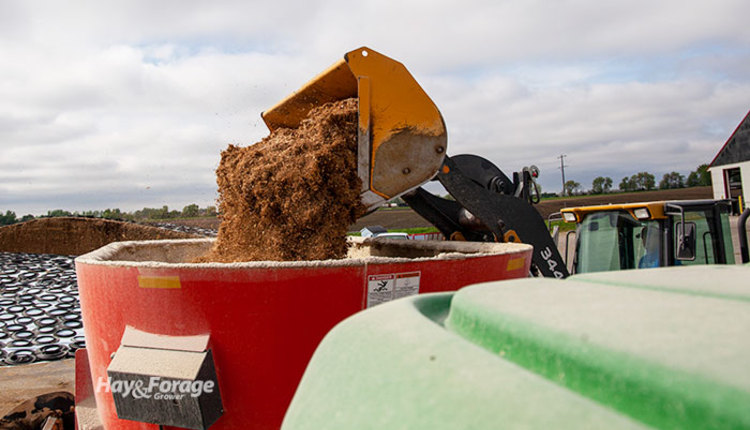
Alfalfa and corn silage are a dynamic duo in dairy cattle diets because of their complementary components; however, these forage crops have demonstrated opposite production trendlines during the recent years.
More acres of corn silage are being grown instead of alfalfa because the former has a higher yield potential and requires less intensive management. Corn silage is making up a rising percentage of dairy diets, but nutritionists like Rick Grant suggest that alfalfa still deserves a prominent place in a balanced ration.
Grant, president of the Miner Research Institute in Chazy, N.Y., discussed alfalfa-corn silage ratios at World Dairy Expo’s Dairy Forage Seminar Stage in Madison, Wis., last week. He noted alfalfa’s benefits from a nutritional perspective, but he also highlighted potential economical and agronomic advantages.
Favorable fiber
Grant stated alfalfa has less neutral detergent fiber (NDF) and more undigested neutral detergent fiber (uNDF) than corn silage; however, cattle can digest alfalfa’s fiber more rapidly than corn silage’s fiber, which improves rumen turnover and may boost feed intake.
Alfalfa also has a higher crude protein content than corn silage as well as rumen degradable protein. This component is especially advantageous to balance the high starch content in corn silage and facilitate efficient rumen function.
“With a shift toward more corn silage and high-moisture corn, starch has a very high rumen fermentability,” Grant said. “The high starch and the high degradable protein complement each other to provide nice, synchronized substrates available to rumen microbes.”
To understand the interactions of these attributes, Grant referred to a study at the Miner Research Institute that was designed to determine the effects that different diet formulations had on milk production.
Five groups of cattle were assigned treatment diets that consisted of 10:90, 30:70, 50:50, 70:30, and 90:10 alfalfa hay to corn silage ratios, and each diet was 62% forage on a dry matter basis. Over the course of five weeks, researchers gathered data on animals’ dry matter intake, milk yield and composition, production efficiency, rumination, and body condition score.
Dry matter intake and milk yield were relatively consistent across all treatments, but milk protein was highest when cattle were fed 30:70 and 50:50 alfalfa hay to corn silage.
“The take-home message from this is that the diets high in corn silage did not change feed intake, milk production, or the efficiency of corrected-milk yield, but the 30:70 combination of alfalfa and corn silage diets resulted in significantly better milk protein output,” Grant said.
Rumination time in minutes per day was also in a desirable range across all treatments, except for the diet with 90:10 alfalfa hay to corn silage. Overall, Grant suggested dairy rations can include up to 90% of forage as alfalfa without major implications to milk production, but milk components were optimized when rations contained 30% to 50% of the forage as alfalfa.
Income and expenses
Moving forward, Grant continued to contemplate purchased feed costs and land use to maintain each diet formulation. Although this research requires a whole-farm modeling approach that has not yet been established, he used estimates based on the Cornell Net Carbohydrate and Protein System (CNCPS) model and forage production metrics from the Minter Institute farm.

“In terms of dollars per cow per day, when producers grow corn silage and purchase alfalfa hay, it’s obviously going to be more expensive with higher alfalfa in the diet,” Grant noted. “When both corn silage and alfalfa are grown on the farm, you often get cheaper diets as alfalfa inclusion rates increase.”
Grant also pointed out income over purchased feed costs were highest when both crops were grown on the farm and rations were 30:70 and 90:10 alfalfa hay to corn silage. Even so, the former diet formulation requires less land than the latter because corn silage has greater yields than alfalfa.

“When you’re feeding more corn silage in the diet, you will need about 1 1/2 acres per cow per year,” Grant said. “On the other hand, when you’re pushing more alfalfa, you will need about 2 acres per cow per year.”
In conclusion, a dairy ration with a higher alfalfa-to-corn silage ratio than what is commonly fed could improve dairy production. Grant encouraged listeners to assess production goals and available resources to determine these ratios on individual farms, but ultimately recommended avoiding extreme inclusion rates of either forage.

Amber Friedrichsen served as the 2021 and 2022 Hay & Forage Grower summer editorial intern. She currently attends Iowa State University where she is majoring in agricultural communications and agronomy.

